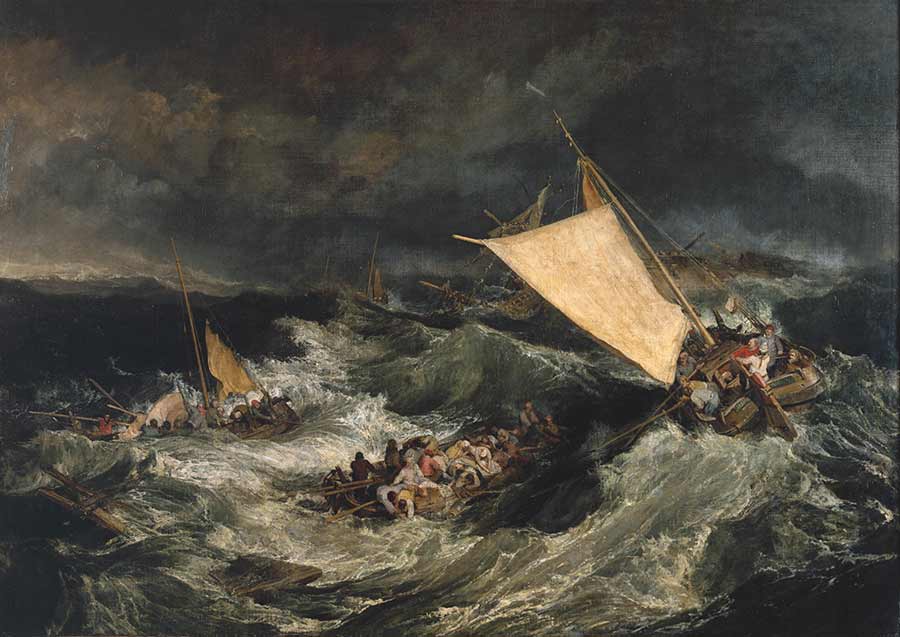Power of Art – Joseph Mallord William Turner: One of Britain’s most celebrated artists, Turner showed exceptional artistic talent from an early age and entered the Royal Academy aged fourteen.
His English landscapes made his name but there was a darker side to his paintings that was difficult for the critics to swallow, both in the increasingly informal use of paint and the subject matter that was critical of the romanticised vision of Britain in the late nineteenth century.
Power of Art – Joseph Mallord William Turner
Joseph Mallord William Turner RA (23 April 1775 – 19 December 1851), was an English Romantic painter, printmaker and water colourist. He is known for his expressive colourisation, imaginative landscapes and turbulent, often violent marine paintings. He left behind more than 550 oil paintings, 2,000 watercolours, and 30,000 works on paper. He was championed by the leading English art critic John Ruskin from 1840, and is today regarded as having elevated landscape painting to an eminence rivalling history painting.
Turner was born in Maiden Lane, Covent Garden, London, to a modest lower-middle-class family. He lived in London all his life, retaining his Cockney accent and assiduously avoiding the trappings of success and fame. A child prodigy, he studied at the Royal Academy of Arts from 1789, enrolling when he was 14, and exhibited his first work there at 15.
During this period, he also served as an architectural draftsman. He earned a steady income from commissions and sales, which due to his troubled, contrary nature, were often begrudgingly accepted. He opened his own gallery in 1804 and became professor of perspective at the academy in 1807, where he lectured until 1828, although he was viewed as profoundly inarticulate. He travelled to Europe from 1802, typically returning with voluminous sketchbooks.
Turner style
Turner’s talent was recognised early in his life. Financial independence allowed him to innovate freely; his mature work is characterised by a chromatic palette and broadly applied atmospheric washes of paint. According to David Piper’s The Illustrated History of Art, his later pictures were called “fantastic puzzles”.
Turner was recognised as an artistic genius: the influential English art critic John Ruskin described him as the artist who could most “stirringly and truthfully measure the moods of Nature”. He’s work drew criticism from contemporaries, in particular from Sir George Beaumont, a landscape painter and fellow member of the Royal Academy, who described his paintings as ‘blots’.
He’s imagination was sparked by shipwrecks, fires (including the burning of Parliament in 1834, an event which Turner witnessed first-hand, and transcribed in a series of watercolour sketches), and natural phenomena such as sunlight, storm, rain, and fog. He was fascinated by the violent power of the sea, as seen in Dawn after the Wreck (1840) and The Slave Ship (1840).
Turner materials
Turner experimented with a wide variety of pigment. He used pigments like carmine, despite knowing that they were not long-lasting, and against the advice of contemporary experts to use more durable pigments. As a result, many of his colours have now faded. Ruskin complained at how quickly his work decayed; Turner was indifferent to posterity and chose materials that looked good when freshly applied. By 1930, there was concern that both his oils and his watercolours were fading.
Turner’s Death
Turner died of cholera at the home of Sophia Caroline Booth, in Cheyne Walk in Chelsea, on 19 December 1851. He is buried in St Paul’s Cathedral, where he lies near to Sir Joshua Reynolds. Apparently his last words were “The Sun is God”, though this may be apocryphal.
He’s friend, the architect Philip Hardwick (1792–1870), son of his tutor, Thomas Hardwick, was in charge of making the funeral arrangements and wrote to those who knew Turner to tell them at the time of his death that, “I must inform you, we have lost him.” Other executors were his cousin and chief mourner at the funeral, Henry Harpur IV (benefactor of Westminster – now Chelsea & Westminster – Hospital), Revd. Henry Scott Trimmer, George Jones RA and Charles Turner ARA.

Pingback: Power of Art - Vincent van Gogh episode 6 - ClumpHD